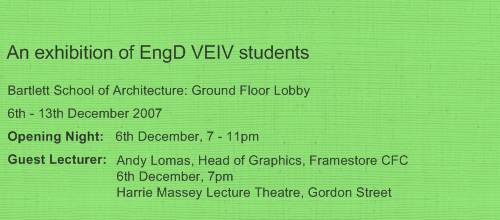| |
| |
|
| [Introduction] |
|
|
This exhibition presents the work of current EngD students on the Virtual Environments, Imaging and Visualization course. Each student introduces their work in progress towards their individual research goals, which represent a cross section of multi-stranded concerns, ranging from computer vision and real-time rendering to simulation and design optimization. The problems addressed by the students often overlap fields of expertise such as computer science, architecture, engineering and complex systems science. By exhibiting the work in the same space together it is hoped that a dialogue between disciplines will emerge that is engaging and relevant and whose interventions straddle both the physical and the virtual realms.
|
| |
|
| [Anthony
Steed - EngD VEIV Director, Computer Science] |
|
|
At one level, the technologies of
virtual environments, imaging and visualisation are
nothing but tools to aid understanding. Within the EngD
centre, students are educated to exploit these tools
within a broad range of engineering disciplines. With
the EngD VEIV we help students develop both core
research skills, and a broad sensitivity to the role of
research in engineering development processes. Thus,
whilst the students' research is equal in complexity and
depth to that undertaken on a traditional PhD, because
EngD students work closely with a sponsoring company and
because there is specific training, they are more aware
of the value and role of research to modern companies
and modern society.
To create this awareness, the EngD, unlike other
doctorates, has a training component, that forces
students to work outside of their native discipline; be
this computer science students being challenged to work
to design briefs, or architecture students working on
collaborative software development projects. We also
provide opportunities, through the UCL collaboration
with the London Business School, to have EngD students
see their research evaluated and challenged in a broader
business context.
The role of computer science in the EngD is to train
toolsmiths with the capability to show new solutions and
new opportunities for the use of imagery. A flavour of
the potential impact can be seen from the breadth of
EngD projects, which range from high performance
character animation for the games industry to real-time
vision for vehicle steering.
Overall, the aim of the EngD programme is to allow students to
do excellent collaborative, inter-disciplinary research.
The industrial collaboration allows students and their
academic supervisors access to resources, facilities and
support within industry that would otherwise be
unavailable and it allows the companies access to
world-class research groups in academia. |
|
| |
|
| [Alan Penn - EngD VEIV
Deputy Director, Bartlett] |
|
|
An EngD is a gold plated PhD with
knobs on (or perhaps with the rough edges knocked off).
Because an EngD is problem driven and relates directly
to a sponsoring organisation's business, it is a
doctorate in which you cannot get away with narrowing
your focus to exclude the facts that don't fit neatly
within a given world view. An EngD tackles real problems
in all their messiness and complexity, and searches for
practical solutions. In doing this it is bound to make
fundamental scientific discoveries, but always those
which have a positive impact.
The range of EngD projects within
UCL's VEIV Centre is phenomenal due to the Centre being
collaborative between the Department of Computer Science
in the Faculty of Engineering and the Bartlett School of
Graduate Studies in the Faculty of the Built
Environment. The collaboration is not a marriage of
convenience, but a result of many years of joint
research activity. Perhaps surprisingly, advanced
computing and architectural design share much in common
and are increasingly becoming integrated both
practically and theoretically. Each field comprises
dynamic and complex systems of which people and
organisations form an integral part.
Architecture has had centuries in
which to develop methods of designing for complex,
multi-factorial and dynamic human systems. It does this
through by fostering advanced communities of practice
through a unique educational system. Today it would not
be able to do manage without the use of advanced
computing, visualisation, optimisation and computer
aided manufacturing; similarly, the leading edge of
computing research deals with human and organisational
factors, as well as the rapidly disappearing boundary
between computation, communication, the built
environment and human users. The theoretical insights
into human and social systems and their relationship to
the design of the environment that come from
architecture now play an important role in the
development of our understanding of new generations of
virtual environments and pervasive computing. The EngD
programme, sitting on the edge between these two
disciplines as well as between the world of business and
the world of theoretical and experimental research,
takes advantage of a unique perspective to pursue highly
original research.
|
| |
|
|

